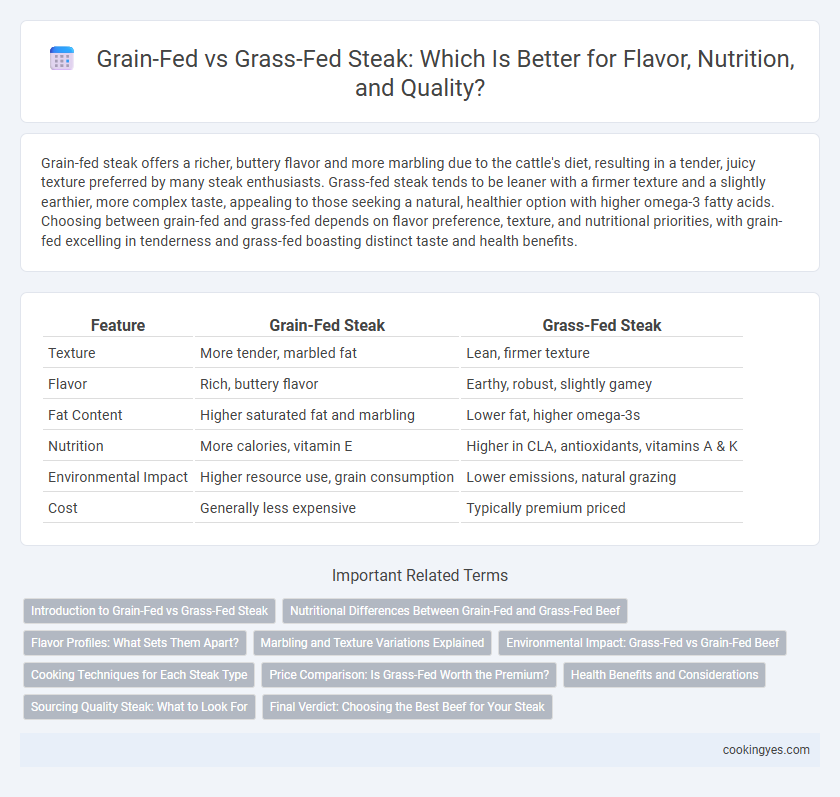Grain-fed steak offers a richer, buttery flavor and more marbling due to the cattle's diet, resulting in a tender, juicy texture preferred by many steak enthusiasts. Grass-fed steak tends to be leaner with a firmer texture and a slightly earthier, more complex taste, appealing to those seeking a natural, healthier option with higher omega-3 fatty acids. Choosing between grain-fed and grass-fed depends on flavor preference, texture, and nutritional priorities, with grain-fed excelling in tenderness and grass-fed boasting distinct taste and health benefits.
Table of Comparison
| Feature | Grain-Fed Steak | Grass-Fed Steak |
|---|---|---|
| Texture | More tender, marbled fat | Lean, firmer texture |
| Flavor | Rich, buttery flavor | Earthy, robust, slightly gamey |
| Fat Content | Higher saturated fat and marbling | Lower fat, higher omega-3s |
| Nutrition | More calories, vitamin E | Higher in CLA, antioxidants, vitamins A & K |
| Environmental Impact | Higher resource use, grain consumption | Lower emissions, natural grazing |
| Cost | Generally less expensive | Typically premium priced |
Introduction to Grain-Fed vs Grass-Fed Steak
Grain-fed steak comes from cattle raised primarily on a diet of corn and other grains, resulting in marbled meat with a rich, buttery flavor and tender texture. Grass-fed steak is sourced from cattle that graze on natural pastures, producing leaner meat with a distinct, earthy taste and a higher concentration of omega-3 fatty acids. Choosing between grain-fed and grass-fed steak depends on preferences for flavor, texture, and nutritional content.
Nutritional Differences Between Grain-Fed and Grass-Fed Beef
Grain-fed beef typically contains higher fat content and marbling, resulting in a richer flavor and juicier texture compared to grass-fed beef. Grass-fed beef is leaner, with lower total fat but higher levels of omega-3 fatty acids, conjugated linoleic acid (CLA), and antioxidants like vitamin E. The nutritional profile difference influences health benefits, with grass-fed beef often favored for its improved fatty acid composition and reduced saturated fat levels.
Flavor Profiles: What Sets Them Apart?
Grain-fed steaks typically offer a richer, buttery flavor with a tender, marbled texture due to higher fat content, making them popular among those who prefer a juicy, savory bite. Grass-fed steaks present a leaner profile with a slightly earthy, robust taste, often described as grassy or gamey, appealing to diners seeking a more natural and intense beef experience. The distinct feeding methods directly influence the fatty acid composition, which shapes the unique flavor profiles and mouthfeel of each steak type.
Marbling and Texture Variations Explained
Grain-fed steaks typically exhibit increased marbling due to the higher energy density of grain-based diets, resulting in a richer, more tender texture prized for its juiciness and flavor. Grass-fed steaks usually have less intramuscular fat, lending a leaner profile with a firmer texture and a more pronounced, earthy flavor profile influenced by forage-based nutrition. These marbling and texture variations directly impact cooking methods and flavor intensity, making grain-fed steak ideal for those seeking buttery tenderness, while grass-fed offers a leaner, robust dining experience.
Environmental Impact: Grass-Fed vs Grain-Fed Beef
Grass-fed beef typically has a lower environmental footprint than grain-fed beef due to reduced reliance on industrial feed crops and synthetic fertilizers, which decreases greenhouse gas emissions and soil degradation. The grazing practices associated with grass-fed cattle can promote soil carbon sequestration and biodiversity, enhancing ecosystem health. However, grass-fed cattle often require more land and longer raising periods, which can increase methane emissions per pound of beef compared to grain-fed systems.
Cooking Techniques for Each Steak Type
Grain-fed steaks, known for their higher marbling and fat content, benefit from high-heat cooking methods like grilling or pan-searing to achieve a juicy, tender texture and rich flavor. Grass-fed steaks, which are leaner and have a firmer texture, require gentler cooking techniques such as reverse searing or lower-temperature grilling to prevent toughness and to enhance their earthy, robust flavor profile. Understanding these cooking differences optimizes tenderness and taste, ensuring the best culinary experience for each steak type.
Price Comparison: Is Grass-Fed Worth the Premium?
Grain-fed steaks generally offer a lower price point compared to grass-fed varieties, which can cost up to 30-50% more due to higher production costs and longer raising periods. Grass-fed beef tends to have a leaner profile with different flavor nuances, often commanding a premium in markets focused on organic and sustainable sources. Consumers weighing price against nutritional benefits and ethical considerations often find the grass-fed option justifiable despite the elevated cost.
Health Benefits and Considerations
Grain-fed steak typically has higher marbling, resulting in a richer flavor and more tender texture but contains higher levels of omega-6 fatty acids, which can contribute to inflammation if consumed excessively. Grass-fed steak offers a leaner profile with increased omega-3 fatty acids, conjugated linoleic acid (CLA), and antioxidants like vitamin E, promoting heart health and anti-inflammatory benefits. Consumers seeking nutrient-dense options often prioritize grass-fed beef for its favorable fatty acid composition and potential to support cardiovascular wellness.
Sourcing Quality Steak: What to Look For
Grain-fed steak offers marbling that enhances tenderness and rich flavor, while grass-fed steak provides a leaner profile with higher omega-3 fatty acids and antioxidants. When sourcing quality steak, prioritize USDA grading, with Prime and Choice grades indicating superior marbling and texture. Transparency in sourcing practices ensures ethically raised cattle and consistent meat quality, vital for discerning steak connoisseurs.
Final Verdict: Choosing the Best Beef for Your Steak
Grain-fed beef offers a richer, more marbled texture with higher fat content, ideal for those seeking tenderness and intense flavor in steak. Grass-fed beef provides a leaner, more nutrient-dense option with a distinct, earthy taste and higher levels of omega-3 fatty acids. The best choice depends on personal preference, balancing desired flavor profile, nutritional benefits, and cooking style.
Grain-Fed vs Grass-Fed for Steak Infographic

 cookingyes.com
cookingyes.com